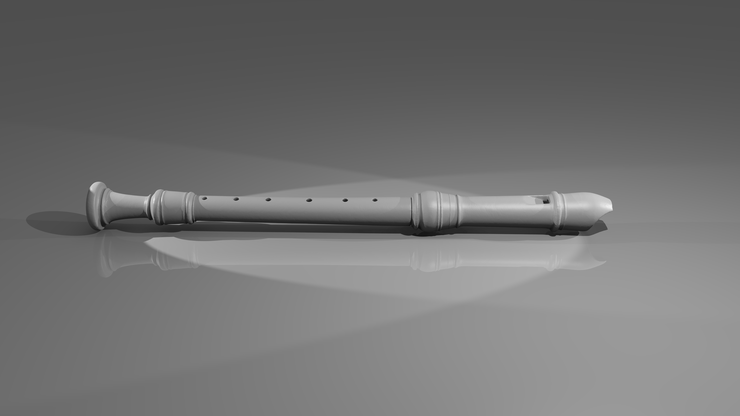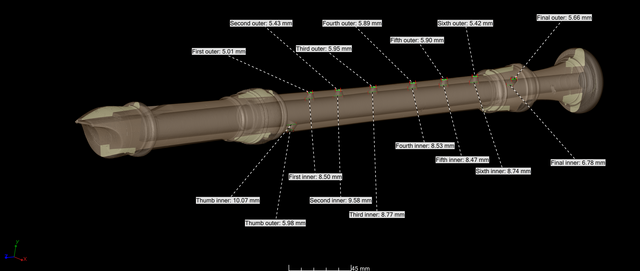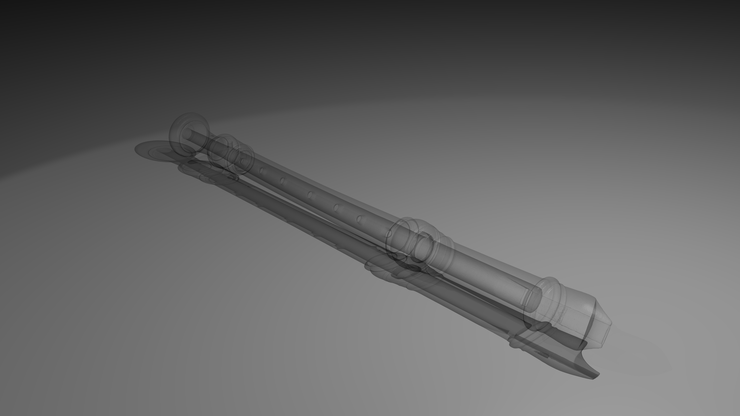
μ-VIS X-ray Imaging Centre
Multidisciplinary, multiscale, microtomographic volume imaging at Southampton
Example

Andrew Pinnock1, Richard Boardman2, Mark Mavrogordato2, Andrew Lamb3, Ian Sinclair2
1Department of Music, University of Southampton; 2μ-VIS X-ray Imaging Centre, Faculty of Engineering and the Environment, University of Southampton; 3Bate Collection, Faculty of Music, University of Oxford
Very few original 18th Century recorders survive in playing condition, and for conservation reasons those that can be played rarely are. Modern "historically informed" players depend on modern makers to approximate the sound and behaviour of these precious original instruments, and in turn the makers rely on measurements of original instruments.
The μ-VIS X-ray Imaging Centre had the opportunity to perform a CT scan of a treble recorder from the University of Oxford's Bate Collection. The recorder, made by Pierre Jaillard (or "Peter Bressan", as he was known in England), is regarded as probably the most influential 18th Century recorder in any collection - private or public - anywhere in the world.

CT scanning delivered a set of measurements of this instrument with unprecedented detail, particularly with respect to the internal geometry of the recorder, throwing valuable light on Bressan's methods.
The bore of the instrument has distorted in a very complex way over 300 years, and the present shape is impossible to reproduce using normal woodworkers' tools. When new, the recorder's internal geometry was much "cleaner" and regular, and doubtless had a different sound.

Distortion in the windway area is severe, where ivory and wood sections have distorted differentially, and significant stress cracking has occurred, yet the instrument still performs well - Bressan voicing seems extraordinarily robust. Chamfer angles at the south end of the windway and the position of the edge vis-a-vis the floor and ceiling of the windway are critically important design features, and are now copyable with reference to the CT scan data should anyone wish to do that (the thinness and fragility of the edge make it hazardous to measure physically with feeler gauges or callipers; in this area CT scanning produced information not previously obtainable).
CT imaging also lets us view the tonehole undercutting in 3D for the first time. 18th century makers and historically-informed modern copyists undercut toneholes when tuning the near-complete instrument using a scalpel or small file. Where they open into the bore, undercut holes are noticeably bigger than they appear on the outside. Optimally placed toneholes are undercut symmetrically; toneholes drilled in slightly the 'wrong' place can be undercut asymmetrically or elliptically, moving them effectively up or down the instrument.

Bressan's tonehole undercuts, as revealed by the CT work, open the holes out evenly rather than elliptically, suggesting that Bressan had found an optimised design. There is no evidence of special tweaking at the master's bench, and no "design secrets" came to light. In principle, modern makers can copy the original, minus bore distortion, and expect their instruments to behave much like Bressan's when new.
They will not behave in the way the real Bressan behaves today - complex, age-related and unreproducible bore distortion has acoustic implications. To create a new instrument approximating the 'feel' and sound of the original, makers can complicate the initially fairly regular bore profile achieved using reamers, artificially introducing distortions to mimic those the original acquired over a long period of time. Departing from the Bressan's likely original measurements somewhat, they may be able to build a new instrument which sounds and handles more like the old one. These are two different approaches to 'copying'. Replication or emulation is the choice, to use Bruce Haynes' terms (Haynes, The End of Early Music (Oxford, 2007), chapter 8). CT scan results should interest makers in both camps, though they're practically valuable mainly to replicators.